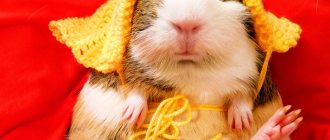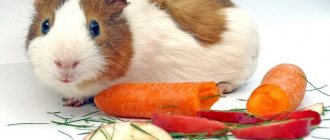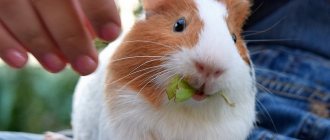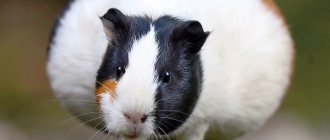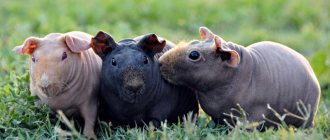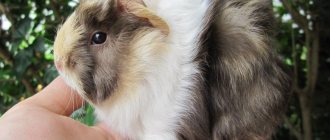In what situations does a guinea pig squeak? Why do they squeak and what do such sounds mean? We learn to distinguish sounds and understand our pet. Pay attention to sounds and body language. Sounds and movements that indicate that the animal needs help. Sounds and movements that indicate your guinea pig is completely happy.
Speaking about guinea pigs, we imagine funny and cute animals that bring joy and a lot of positive emotions.
But you should always remember that when a person gets a pet, he takes full responsibility for it. If an animal is sick, something is bothering or bothering it, it cannot talk about it, so the owner should study his pet well in order to know exactly when and how to act in this situation.
Next, we will find out why a guinea pig squeaks and makes other sounds, and we will become familiar with the body language and habits of the rodent.
They want to get their favorite treat
They skillfully beg for treats and at the same time can be quite demanding. It is worth saying that they even resort to tricks and various feats in order to get what they want.
Often the method works as follows: they stand on their hind legs, begin to make a sound that resembles a squeak or even a squeal, while they look the owner straight into the eyes, can a person resist such an action, of course not, so the cunning little animal gets what I wanted my favorite treats.
It happens that when an animal begs for a treat, a person joyfully presents it with a treat, but she shows with all her appearance that she is very unhappy, that she was expecting something else. Know that your rodent is very spoiled and you should stop indulging in his whims.
Longhair
Unusual and beautiful guinea pigs with long hair come in completely different varieties and have the most unusual names. At first glance, it is very difficult to understand which animal is in front of your eyes: a shaggy dog or a fluffy bunny. These thoroughbred “hippies” appeared thanks to the incredible efforts of breeders. Almost all rodents have thick and long hair, which in some breeds can exceed 45 centimeters.
Sheltie
These guinea pigs are very nice to touch as they are quite soft to the touch. Their fur, unlike other relatives, does not have a parting, but simply falls back. The hair on the head is thicker and somewhat resembles a mane. Like other long-haired animals, Shelties are friendly and calm.
Coronet
These are the most active representatives among all guinea pigs with long hair. Their characteristic feature is a single rosette on the head. The long fur flows on both sides, but does not cover their face.
Alpaca
This beauty has very long and curly fur. It looks a little like sheep's wool. In addition, it grows towards the head. There are 2 rosettes on the sacrum, another one is located on the head, and looks like a bang.
The fur on the face is a little coarser than on the rest of the body. Alpaca guinea pigs are quite compact, with small and neat ears. Their color is very different - from black to golden. In rare cases, you can even find two-color or three-color alpacas.
Texel
This is the most beautiful breed of long-haired guinea pig, and it was the result of crossing two breeds: Sheltie and Royal (Rex). Their curly fur grows from the head. In addition, it cascades across the entire back from the parting, framing the head without long hair. The length of the hairs can reach up to 15 centimeters.
This breed of pigs is a bit like fluffy balls that you want to pick up. They have beautiful big eyes and small ears shaped like rose petals. The color of the texels is quite varied. Among them you can even find white guinea pigs.
Merino
Such guinea pigs are also called royal guinea pigs, and all thanks to their beautiful and curly hair. Their head is decorated with a rosette that resembles a crown. The fur is very long, so owners often have to cut their pets in the summer. Their color can be white or gray, and also combine several shades at the same time.
Peruvian
This breed of pigs has become quite popular due to its docile nature, as well as its beautiful appearance. Their fur is very soft and long, so it requires constant care. There are rosettes on the sacrum and also on the nose. The animal's face is covered with long bangs.
Peruvian guinea pigs can be single or multi-colored, but most often their color is silver-gray. They live no more than 6 years and weigh up to 1.5 kilograms.
Kui
This is the largest breed of guinea pigs, sometimes weighing up to 4 kilograms. Most often they are raised for meat. Cuis are more considered to be smooth-haired breeds of pigs, but among them it is worth noting Peruvian animals that are bred as decorative creatures.
This species reproduces poorly and is also prone to various diseases. In addition, they have a very aggressive character. Almost all kui have 5 or 6 toes on their paws, however, this does not bother them at all. Most of them do not live very long, within 3 years.
Really hungry
Of course, owners should not forget to feed their pets. The situation that in everyday activities they simply forgot to give the animal food is rare, but it does happen.
But at the same time, the animal will not stop wanting to eat and you will still have to feed it. The guinea pig will definitely remind you of itself; if it is hungry, it will make very persistent and demanding sounds. She will squeak for a long time until she is finally fed. To avoid such concerts at night, be sure to pour food in the evening.
How to understand what a pig needs
The main thing that the owner of the animal needs to learn to understand it is diligence and attentiveness. Many animals have their own, characteristic style of communication. But still, the meanings of most sounds are the same for all pigs. Therefore, it will not be difficult to find out why guinea pigs squeak, whistle, sniffle and make other sounds. But in order to correctly understand your pet, it is important to correctly recognize the sound being made - growling or rumbling, hissing or snuffling, etc.
Show their superiority
If several representatives of guinea pigs live together, be sure to expect competition in everything. There will be stronger individuals who will want to show their superiority over their weaker relatives.
During such manifestations, a squeak is also made, but these sounds sound more menacing, even reminiscent of a roar. Such sounds bring other relatives into a state of calm, they become obedient and flexible. In other words, they restore order in their family.
How should a person react if a rodent chatters its teeth?
If a pet shows concern, owners should be wary. The first thing you need to do is check if everything is okay with the animal. Perhaps he does not like the temperature in the room (too cold or hot), he is negatively affected by loud sounds coming from the TV, strong odors, and the like.
With prolonged aggression on the part of a guinea pig, the most common causes are:
- unpleasant proximity to relatives;
- tight cage;
- new items in the cage.
When buying a guinea pig, you should not immediately buy it new toys, a neighbor, a house and other little things. Let the animal get used to the move and its new owners, and only then gradually add objects that are unfamiliar to it. Thus, the pig will watch with interest the changes taking place around him and will understand that they do not pose any threat to her.
All guinea pigs are individuals. But they equally express their emotional state with different sounds. The owner’s main task is to listen to them and be able to recognize what the pet wants and what its mood is.
Because of fear
When they are scared, they will squeak, these are quite plaintive sounds, and they also hide in the corner of the cage or climb into the house. They can also make plaintive squeaks because they don’t like something.
Often the younger generation behaves this way, animals that have just been adopted and have not yet had time to get used to humans. Adults, when they are scared or don’t like something, on the contrary, do not hide, but try to attract the attention of the owner so that he can correct it.
Contacting a veterinarian
However, sometimes an animal’s unusual behavior can also mean health problems. If the pet jumps around the cage, lies around, itches itself on everything, and the fur looks dull, begins to fall out and bald patches appear - this indicates the appearance of skin parasites. An animal can become infected with them not only by walking down the street. Often flea or tick larvae get to the animal along with low-quality hay or bedding, as well as poorly washed food. If your pig shows anxiety and loses his appetite, you should consult a doctor. Analysis of the skin scraping will determine both the type of parasite and the degree of infection.
Only a doctor can shorten teeth that have not been ground down
If all the conditions of keeping are met correctly, the pig receives a lot of attention and has a large living space, but suddenly it starts gnawing on cage bars or other objects - this may indicate problems with teeth or the presence of intestinal parasites. You can determine a worm infestation by carefully examining your pet's stool—most often, eggs or adult worms are found in the feces. For treatment, you can use Shustrik paste, which is sold at any veterinary pharmacy. If your pig has dental problems, then a visit to the doctor is a must.
Most often, in this way the animal tries to grind down excessively long incisors, which cause discomfort. In other cases, the animal tries to get stuck pieces of food or shows that its teeth are not properly rooted. Correcting a bite can only be done in a veterinary clinic. The procedure does not take much time and brings instant relief.
Got sick
As a rule, when an animal is sick, this manifests itself not only in the squeak it makes, but also in its appearance and behavior. If they don’t feel well, they try to retire, hide in a house, hide in a corner, and when in pain they begin to squeak loudly.
If the owner is faced with such a situation, the animal should be immediately shown to a doctor. Diseases in rodents develop very quickly and have serious consequences. There is no time to waste to prevent complications.
Variety of breeds
Species diversity is characteristic not only of dogs and cats, but also of guinea pigs. The photos demonstrate that there are both short-haired and long-haired breeds. The conditions of detention are the same for all, with the exception that long-haired dogs need to be combed and, in some cases, trimmed. The most popular breeds are:
- American Teddy;
- English self;
- satin;
- alpaca;
- skinny;
- Himalayan;
- Peruvian;
- Abyssinian;
- Sheltie;
- texel;
- crested.
They all have differences in coat type and color, as demonstrated by photos of guinea pigs. In addition, there are outbred smooth-haired and rosette pigs. Everyone is equally good-natured, trusting and timid, which makes them incredibly cute.
Hums
In fact, they can rumble in different ways. If this is a quiet, calm purr, it means they are very happy and contented, perhaps they like to sit in your arms, or the treat was tasty, they like it when they scratch behind the ear or on the back, or maybe they liked a walk around the room, there can be many reasons , but it really brought pleasure to the pet.
When she purrs loudly, so to speak in a raised voice, it is not pleasure at all, but on the contrary, she is irritated and dissatisfied. This can be caused by loud noise, sudden movement and other situations.
If this is an intermittent rumbling, which is accompanied by trembling in the body, then the animal is experiencing fear, there is something that frightens it or brings discomfort. It is necessary to understand this situation, find the cause and eliminate it so that this does not happen again.
Why does the pig scream, squeal and whine?
These sounds are equivalent to an alarm. Hearing them, the owner should run to the animal - it calls for help. The reasons can be different - the pet is scared of something, he feels bad or is in pain. In any case, he needs support and love.
If your pet screams or squeals, first of all you need to examine him. Perhaps he fell or got into a fight with a relative, or someone offended him. It is imperative to make sure that the animal is not injured and there are no abrasions on its body. If damage is detected, medical attention must be provided to him.
By moaning and whining, the little furry is able to express his dislike for someone (a person or a relative) or simply signal his loneliness. Regardless of the reason, the animal needs to be comforted and cuddled. Nothing makes a pig as happy as the owner's love. Well, and a delicious treat, of course.
Language of the body
Of course, owners need to pay attention not only to the sounds their pet makes, but also to behavior, namely body language.
If the animals are running around the cage, jumping and jumping merrily, it means they are in a good mood and want to play with their owner. But remember that if they are jumping just like that, they do not intend to play and are generally in a bad mood, then they are worried about parasites that cause bites, and urgent help is required.
You can observe how the pig freezes in one position and does not even move, this means that she saw something that led to confusion and great surprise.
Remember that they sniff absolutely everything, not only objects, a cage, an apartment, but also a person, this is how they get to know everything around them. They greet their relatives by touching their noses, so touching a person indicates a greeting.
Often the animals are friends with each other and there is no aggression among them. Situations are possible when males perceive each other as rivals if there is a female nearby.
Then, of course, they want to be first and best, so they may stand on their hind legs to surpass their enemy. At the same time, they hiss and grind their teeth, and the fur rises in the area of the withers.
If a person observes such a situation, be sure to intervene and separate the opponents into different cells, since they can harm each other.
It is possible to display aggression by swaying the body from side to side; they also make such movements during the mating season.
If you are playing with your pet and suddenly he becomes restless and fussing, this may mean that he needs to go to the toilet or is simply hungry. Therefore, it is worth interrupting the exciting game and putting the little animal in a cage.
Also, during games, the animal can lie down in the owner’s arms and throw back its head, this is how he shows that he is already tired and wants to go home to his cage. But when they lick the owner’s hands, this is how they show their love.
Moments to be wary
A heart-rending cry means that the animal is afraid or feels pain. And at the moment he feels bad. As soon as you hear something like this, immediately go to your pet to see if everything is okay with him.
You should also pay special attention to teeth grinding. This means that the animal’s teeth begin to grow, but toys and solid food do not help.
If the situation is left unchecked, an infection may occur. And in this case, you should immediately consult a doctor.
A veterinarian tells more about the language of communication between guinea pigs and the outside world in the video below.
A rare sound made by guinea pigs. It really is very similar to the chirping of birds. Not all guinea pigs make this sound. Many owners have never heard it from their pets. But some people have a pig (or even a pair) that makes this sound relatively often.
This chirping can vary in frequency (faster, slower) and volume. It may seem that while chirping the pig is in a trance-like state: some climb onto the house and sing their “song” with their heads held high; some climb into a secluded place (a pipe, a house, huddle in a corner) and look extremely worried. At the same time, the pig sits motionless, not paying attention to anything, with his eyes wide open, looking at one point. Usually, relatives living in the same cage with the songbird or in the same room become quiet and can also sit motionless.
The duration of such “singing” can range from 30 seconds to 20 minutes. When the singing ends, the pig goes about its normal business as if nothing had happened. This behavior and the meaning of this “song” are the subject of much debate. There are different explanations for this behavior.
In the book “Behavioral Differences Between Domestic and Wild Guinea Pigs” (Mammaliology Section, Vol. 52, 1987, pp. 294-307)*, Dr. Adelheid Stanke defines chirping as follows:
“Chirping is one of the loudest sounds in the vocalization repertoire of guinea pigs. Sounds are produced in quick, rhythmic succession. When guinea pigs can be observed doing this activity, in addition to the mouth, the whole body also moves under the influence of the efforts made to reproduce this sound. The chirping can occur for up to 20 minutes, during which a maximum of 100 sounds per minute will be produced. In 20 minutes, 800 sounds were counted.
The chirping has been recorded in two different situations: animals in a state of high arousal and stress following a major conflict. In the first case, the sound was a response to an unfamiliar environment or an unexpected sound. In the second (the most common of a number of cases) during specific social phenomena within the group, such as the establishment of rank or during conflicts (in males), when females were ready to reproduce. The chirping never occurs during skirmishes, but often only after several minutes or hours.”
Norbert Sachser (“Social Physiology: Guinea Pig Studies.”*) describes chirping as a stress signal. He's writing:
“Animals chirp mainly when they are socially overloaded, which does not allow them to cope properly in a certain social situation. Overall, chirping is a very rare occurrence.”
People have offered various reasons and explanations for this unusual behavior. Many guinea pig owners have concluded that chirping often occurs during the estrous period of females and in cases of ambiguous social status of the pig in the group, especially when joining an established flock. Often, skirmishes, conflicts and clarification of social rank are the cause of tweeting. The pig cannot occupy a certain level on the hierarchical ladder, which causes it to be in a state of stress. Also, there is an assumption that they tweet out of loneliness. It has been noted that in the wild this signal is a “warning” to other pigs that danger is nearby.
Conclusion:
Various factors are responsible for the mysterious chirping of guinea pigs. To make approaches to explain this phenomenon and more or less understand your pet, you need to observe him before and during this behavior.
Let's sum it up
It is worth saying that understanding your pet is not so difficult, the main thing is to want to hear it. You should always remember that these are living beings that experience fears, dissatisfaction, hunger, irritation, and it is very simple to understand the state of the animal.
Pay more attention to your guinea pig, they love affection very much and need your care constantly. If you know how they manifest a particular condition, you can avoid many difficulties and promptly pay attention to the problem. Knowing your animals, you will make them happy, and they will give you a lot of positive emotions.
What to feed?
Guinea pigs are herbivores, so the basis of their diet should be hay. It should be in the cage at all times, just like water and food. Specialized food for such rodents can be purchased at a pet store. At the same time, you should avoid those that contain grain, as it is not absorbed properly in the animal’s stomach.
In addition to dry food, a guinea pig should receive two servings of fresh vegetables and fruits, as well as herbs daily - they are rich in vitamins and microelements and are vital. The optimal dose of succulent food is about 10% of the animal’s own weight daily.


